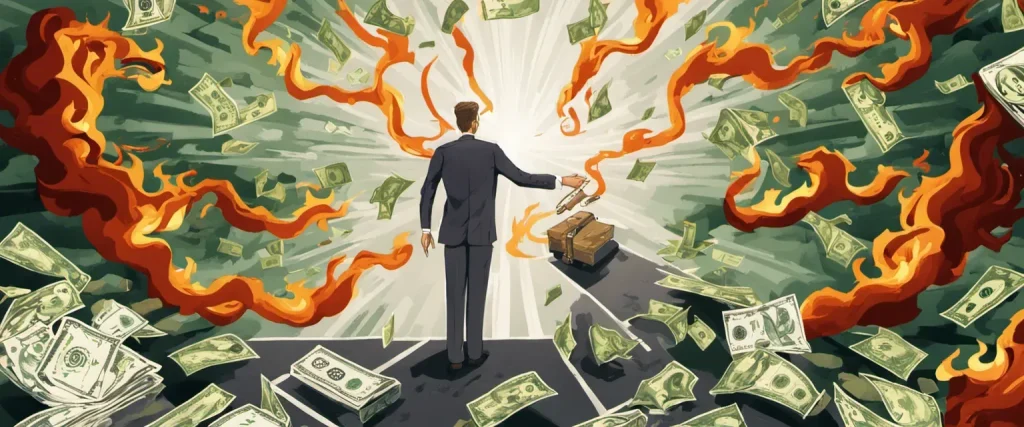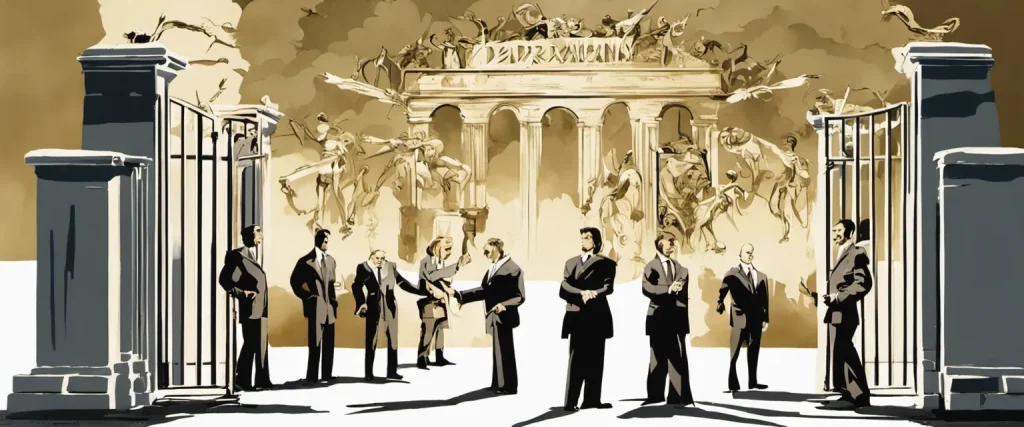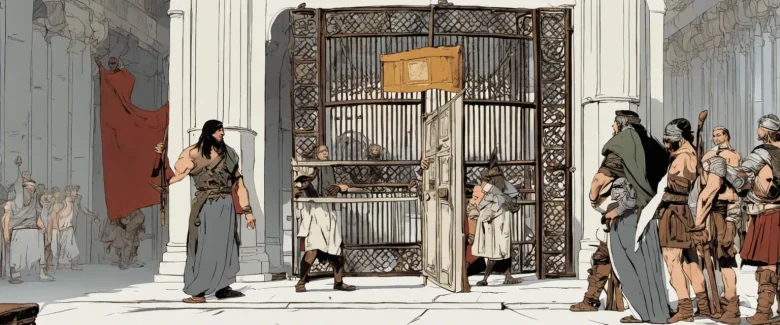In the gripping account of one of the most iconic corporate takeovers in history, “Barbarians at the Gate,” Bryan Burrough presents an enthralling narrative that delves into the heart of the financial world. Published in 1989, this bestselling book uncovers the intense battle for control over RJR Nabisco, a massive conglomerate comprised of globally recognizable brands. Burrough, an accomplished journalist and author, blends his expertise in business reporting with impeccable storytelling skills to deliver a captivating exploration of greed, ambition, and the complex workings of Wall Street. Throughout his career, Burrough has established himself as a renowned financial journalist, renowned for his meticulous research and ability to dissect intricate economic events with clarity and precision.
Chapter 1: The Making of RJR Nabisco
Chapter 1 of “Barbarians at the Gate” by Bryan Burrough provides an in-depth overview of the events leading up to the leveraged buyout (LBO) of RJR Nabisco, one of the largest tobacco and food conglomerates in the United States during the 1980s.
The chapter begins by introducing the central figures in the story: F. Ross Johnson, the CEO of RJR Nabisco, and Henry Kravis, a prominent private equity investor from the firm Kohlberg Kravis Roberts (KKR). Burrough describes Johnson as a charismatic and extravagant leader, known for his lavish lifestyle and unconventional management practices.
The chapter then delves into Johnson’s ambition to take RJR Nabisco private through a leveraged buyout. He believed the company’s stock was undervalued and sought to gain control over it. However, various factors, including the skepticism of Wall Street and the board’s initial reluctance, initially impeded Johnson’s progress.
Burrough highlights the relationship between Johnson and Kravis, noting the contrasting styles and motivations between the two. Johnson was driven by ego and the desire for personal success, whereas Kravis was primarily focused on financial gains. Eventually, Kravis recognizes the value of RJR Nabisco and decides to compete with Johnson for the leveraged buyout, leading to a bitter and intense rivalry between the two.
The chapter concludes with the announcement of the bid for RJR Nabisco, which sets off a frenzy of media attention. Many Wall Street firms are intrigued by the potential profits of the LBO, and investment bankers scramble to secure their piece of the deal.
Overall, Chapter 1 provides a captivating introduction to the RJR Nabisco LBO saga, setting the stage for the intense bidding war and the subsequent tumultuous events that shape the narrative of “Barbarians at the Gate.”
Chapter 2: The Rise of F. Ross Johnson
Chapter 2: The Rise of F. Ross Johnson of the book “Barbarians at the Gate” by Bryan Burrough explores the background and ascension of F. Ross Johnson, the charismatic and ambitious CEO of RJR Nabisco.
The chapter delves into Johnson’s early life, growing up in Montreal with a modest background and his knack for salesmanship. He displayed natural talent and ambition while working for Standard Brands, a food conglomerate where he climbed the corporate ladder. However, Johnson’s potential truly flourished when he joined RJR Nabisco, a tobacco and food conglomerate, as the CEO in the late 1980s.
Burrough highlights Johnson’s often unconventional management style, emphasizing his audacity and willingness to take risks. Johnson believed that companies needed a bold leader to challenge the status quo and achieve significant growth. As a result, he embarked on a series of large-scale acquisitions, such as delving into the wine business and purchasing companies like Del Monte. These moves dramatically increased RJR Nabisco’s size and diversified its portfolio, but it also left the company with a staggering debt burden.
Moreover, the chapter explores Johnson’s flamboyant lifestyle and lavish spending habits, which attracted public attention. Johnson’s extravagant parties and expensive tastes often led to criticism within the company and from the public, adding a layer of intrigue to the narrative.
In summary, Chapter 2 highlights how F. Ross Johnson rose through the ranks of corporate America, showcasing his shrewdness, ambition, and audacity as he led RJR Nabisco to both massive growth and a crippling debt load.
Chapter 3: The Takeover Battle Begins
Chapter 3: The Takeover Battle Begins of “Barbarians at the Gate” by Bryan Burrough covers the initial stages of the battle between the leveraged buyout (LBO) firms, KKR and Forstmann Little, to acquire the food and tobacco conglomerate, RJR Nabisco.
The chapter starts with a meeting between Henry Kravis and George Roberts of KKR at their New York headquarters. They discuss the current state of the takeover market and the potential for acquiring RJR Nabisco. They decide to pursue RJR Nabisco due to its vast portfolio and potential for profitability.
Meanwhile, at Forstmann Little, Ted Forstmann meets with his team and explains their strategy to acquire the conglomerate. Forstmann believes that the management team at RJR Nabisco is stagnant and that the company has the potential to increase its value significantly under new ownership.
As the battle commences, both KKR and Forstmann Little begin to gather their teams of investment bankers and lawyers. Both firms scramble to create the largest LBO in history, and they know that the bidding process will be fierce.
The chapter also highlights the skepticism from Wall Street and the media regarding the feasibility of such a large transaction. Many question the ability of private equity firms to finance such a deal, considering the enormous debt involved.
The chapter concludes with the formal announcement that RJR Nabisco is indeed up for sale. The battle for this corporate giant officially starts, with KKR and Forstmann Little at the forefront. Both firms are poised to pursue RJR Nabisco aggressively, setting the stage for a dramatic and historic takeover bid.
In summary, Chapter 3 sets the stage for the intense battle between KKR and Forstmann Little to acquire RJR Nabisco. It introduces the key players, their respective strategies, and the doubts surrounding the feasibility of the deal. The chapter sets the tone for the intense competition and high stakes that will unfold in the following chapters.
Chapter 4: Bidding Wars and Wall Street Tactics

Chapter 4 of “Barbarians at the Gate” by Bryan Burrough, entitled “Bidding Wars and Wall Street Tactics,” explores the intense competition between potential buyers and the aggressive tactics employed during the bidding process for RJR Nabisco.
The chapter details how private equity firm Kohlberg Kravis Roberts (KKR) starts with their original bid for RJR Nabisco and faces competition from a variety of other interested parties, including management buyout groups, investment banks, and leveraged buyout firms. As the bidding war intensifies, the price for RJR Nabisco skyrockets, coming into the billions of dollars.
During this process, several intriguing tactics are used. Some bidders strategically cooperate with others to increase their chances of winning, forming alliances to pool their resources and expertise. Wall Street investment banks, acting as advisers to potential acquirers, are presented as meddlesome and double-dealing, trying to manipulate the process to benefit themselves and their clients.
Burrough focuses on the conflicts of interest that arise when Wall Street bankers advise both the potential acquirers and the target company, RJR Nabisco. This creates a web of entangled loyalties and provides an insider’s look at how investment banks maneuver and strive to control the outcome of this lucrative deal for their own gain.
Despite the complex negotiations and behind-the-scenes machinations, the chapter ends without any decisive winner in the bidding war. The price continues to escalate, as each bidder tries to outdo the other. The intense competition and high-stakes nature of the bidding process demonstrate the ruthless nature of Wall Street deal-making and the lucrative potential of acquiring a major corporation like RJR Nabisco.
Chapter 5: Ted Forstmann Enters the Fray
Chapter 5 of “Barbarians at the Gate” provides an overview of how Theodore “Ted” Forstmann, a prominent Wall Street financier, entered the battle for RJR Nabisco alongside his investment firm, Forstmann Little & Co. The chapter documents Forstmann’s decision to challenge the other bidding parties and his strategies to acquire the massive company.
Forstmann saw the opportunity to potentially obtain a major stake in RJR Nabisco, despite the company’s current management favoring a leveraged buyout. He believed the company had great potential and wanted to keep it intact, which aligned with his investment philosophy of long-term growth.
To join the bidding fray, Forstmann had to assemble a formidable team. He partnered with early investment banking pioneer, Henry Kravis, and enlisted John Shad, former chairman of the Securities and Exchange Commission (SEC), as an advisor, adding credibility to his bid. With a team in place, Forstmann put forward a $75 per share offer to the RJR Nabisco board, defying expectations that he would merely be a minor player in the takeover battle.
Forstmann’s bid started to gain support from several large shareholders who were interested in maintaining RJR Nabisco’s integrity as an institution. However, to compete with the likes of Kravis and Ross Johnson, the CEO of RJR Nabisco, Forstmann had to demonstrate his seriousness by committing hundreds of millions of his own capital to the deal. This act surprised many on Wall Street, where it was unusual for investors to risk their own money in such high-stakes transactions.
Chapter 5 ends with Forstmann’s bold move, a higher bid that catches everyone off guard, thus solidifying his entry into the complex and contentious battle for control over RJR Nabisco.
Chapter 6: The Final Showdown
Chapter 6: The Final Showdown of “Barbarians at the Gate” by Bryan Burrough is a pivotal chapter that delves into the climactic battle between two rival companies, RJR Nabisco and Kohlberg Kravis Roberts & Co (KKR), as they compete for control of Nabisco, one of America’s largest conglomerates, in the late 1980s.
The chapter begins with Ross Johnson, the charismatic CEO of RJR Nabisco, realizing that he needs to form a plan to outmaneuver KKR’s bid. Johnson meets with prominent investment bankers and shareholder representatives to discuss potential strategies. Ultimately, Johnson proposes a leveraged buyout (LBO) plan, which involves borrowing massive amounts of money to finance the acquisition of Nabisco. Although risky, the LBO plan would allow him to retain control over the company and ultimately profit handsomely.
Meanwhile, Henry Kravis, the leader of KKR, seeks to counter Johnson’s bid. He orchestrates a meeting with Johnson, where he subtly threatens to launch a hostile takeover if Johnson’s bid fails. Kravis’s tactics strategically put pressure on Johnson to increase his own offer.
As the battle between the two companies intensifies, Johnson becomes increasingly desperate to secure the necessary funds for his bid. This leads him to approach different financial institutions and insurance companies, all of whom are skeptical of backing such an enormous and complex deal.
Ultimately, KKR emerges as the winner, presenting a higher bid that the Nabisco board accepts. Johnson is devastated as he witnesses his dreams of retaining control crumble. The chapter concludes with the realization that despite the loss, Johnson will still walk away with a staggering personal fortune as a result of the deal.
In summary, Chapter 6 of “Barbarians at the Gate” outlines the heated battle for control over RJR Nabisco, with Ross Johnson’s risky LBO plan pitted against Henry Kravis’s aggressive tactics. The chapter encapsulates the climax of the takeover battle, highlighting the triumph of KKR, Johnson’s devastating defeat, and the immense personal gains that follow.
Chapter 7: A Pyrrhic Victory
Chapter 7: A Pyrrhic Victory of the book Barbarians at the Gate by Bryan Burrough focuses on the fallout of the battle between RJR Nabisco and KKR, which had resulted in an acquisition of RJR Nabisco by KKR.
The chapter begins with KKR’s victory celebration, as they successfully acquired RJR Nabisco for a staggering $25 billion. However, the celebration is somewhat short-lived as the reality of the enormous debt they incurred to finance the acquisition sinks in. KKR had to borrow over $20 billion, which was the largest amount of money ever borrowed for a corporate takeover at that time.
The chapter delves into the personal lives of key characters, including KKR partners Henry Kravis and George Roberts. It reveals their struggles to maintain personal relationships amidst their demanding professional lives and the immense pressure caused by the huge debt they accumulated. The partners are portrayed as determined businessmen who were not immune to the emotional toll the acquisition had taken on them.
Meanwhile, the employees of RJR Nabisco are facing an uncertain future as KKR implements drastic cost-cutting measures to control the debt. Thousands of employees are laid off, and the company’s corporate culture is dramatically changed. The chapter highlights the human aspect of the acquisition, depicting the emotional toll it takes on employees who had dedicated their careers to the company.
Overall, Chapter 7 serves as a reflection on the high costs and consequences of corporate takeovers. It brings to light the personal sacrifices made by those involved while shedding light on the impact such deals can have on the lives of employees and the overall corporate culture.

Chapter 8: Consequences and Legacy
Chapter 8 of “Barbarians at the Gate” by Bryan Burrough focuses on the consequences and legacy of the leveraged buyout (LBO) and subsequent sale of RJR Nabisco, one of the largest transactions in corporate history.
The chapter begins by discussing the aftermath of the LBO, which left RJR Nabisco with an enormous debt burden of over $20 billion. The new management team, headed by CEO Ross Johnson, faced the daunting task of growing the company’s profits to service this debt. However, they soon encountered challenges due to the changing landscape of the tobacco industry and an increasingly health-conscious society.
Burrough then explores the legal consequences of the takeover. Various lawsuits and shareholder disputes followed the LBO, with some shareholders accusing Johnson and other executives of acting in their own self-interests rather than maximizing shareholder value. The legal battles dragged on for years, resulting in substantial financial and reputational costs for all parties involved.
The chapter also examines the personal legacies of the key players in the RJR Nabisco saga. For Ross Johnson, the once-celebrated CEO, the outcome was a tarnished reputation and a diminished career. Henry Kravis, one of the original Barbarians who led the buyout, continued to thrive in the private equity industry and founded successful firm Kohlberg Kravis Roberts (KKR).
Overall, the legacy of the RJR Nabisco LBO was mixed. On one hand, the deal showcased the immense wealth and power that could be accumulated through private equity takeovers. On the other hand, it highlighted the potential risks and negative impacts these transactions could have on companies and individuals involved. The transaction also spurred public and regulatory scrutiny regarding the practices and ethics of private equity firms.
In summary, Chapter 8 of “Barbarians at the Gate” highlights the consequences and lasting effects of the RJR Nabisco LBO, including the financial burdens faced by the company, legal battles, and the personal legacies of key players.
After Reading
In conclusion, Barbarians at the Gate by Bryan Burrough provides a detailed and captivating account of the leveraged buyout of RJR Nabisco, giving readers an inside look into the high-stakes world of corporate mergers and acquisitions in the 1980s. The book uncovers the rivalries, greed, and power struggles among the key players, showcasing the lengths they would go to secure victory. Burrough’s thorough research and engaging narrative make Barbarians at the Gate a must-read for anyone interested in understanding the modern landscape of corporate finance and the impact it has on society.
1. The Big Short” by Michael Lewis: If you enjoyed “Liar’s Poker” and want to delve further into the world of finance, “The Big Short” is the perfect recommendation. Lewis takes readers inside the 2008 global financial crisis, detailing the few who saw the impending collapse and made fortunes by betting against the system.
2. Bad Blood” by John Carreyrou: This gripping non-fiction book exposes the deceit behind the rise and fall of Theranos, a healthcare technology company headed by Elizabeth Holmes. Carreyrou unravels the compelling story of how Holmes deceived investors and the public with her fraudulent claims, making it a fascinating read for fans of business scandals.
3. Moneyball” by Michael Lewis: The book delves into the behind-the-scenes world of Major League Baseball (MLB) and sheds light on how the traditional methods of evaluating players and building teams were challenged by data-driven analysis and statistical modeling. Beane and his team at the Athletics relied on advanced analytics and sabermetrics to identify undervalued players and maximize their performance on a limited budget.
4. “House of Cards” by William D. Cohan: For readers interested in the financial industry and its inherent risks, “House of Cards” is a must-read. Cohan exposes the culture of Wall Street through the collapse of Bear Stearns, providing a gripping narrative that combines detailed reporting with captivating storytelling.
5. “The Warren Buffetts Next Door” by Matthew Schifrin: Moving away from financial scandals, this book takes a different approach by focusing on successful investors. Schifrin analyzes various individuals who have achieved impressive investment returns and uncovers their strategies and philosophies. It offers valuable insights to inspire and educate readers interested in the world of investing.



